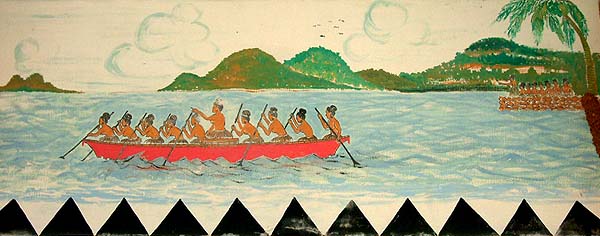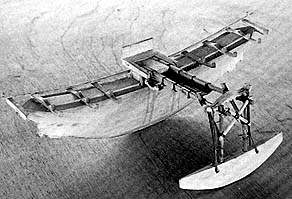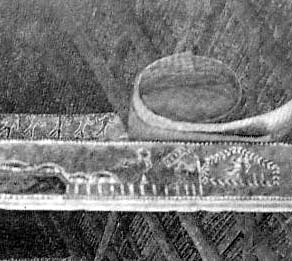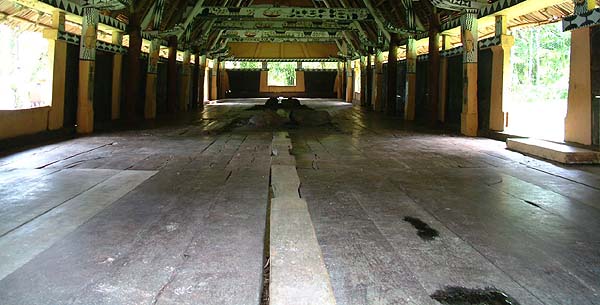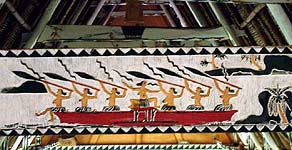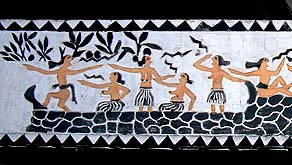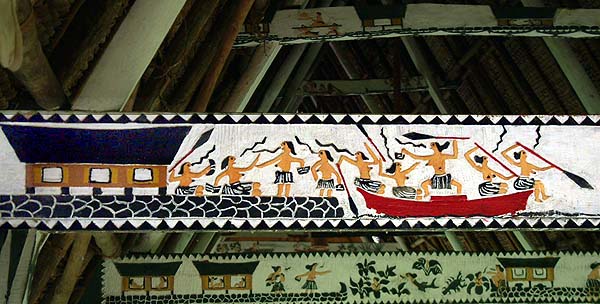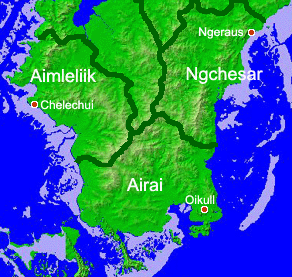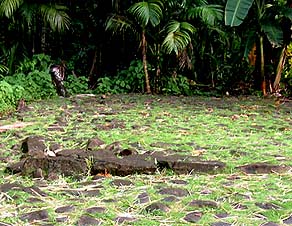 |
 |
 |
 |
||||
|
|
|
|
|
|
|
|
|
|
|
|||||||
|
|
|
|
|
|
"You see that canoe being ridden by women?" Johnson says, pointing to the painting above. "That is a true story, an Airai story. Those women are from Oikull Hamlet, an association of young ladies, known as Ngara-Kerisebsúb, which means the ‘Association of the Curls,' referring to their curly hair." Rurecherudel begins the story: "The people of Oikull village of Airai heard rumors about a beautiful kabékel—that's a war canoe—in Aimeliik, in the village of Chelechui, so they sent this association of young women, the Association of the Curls, to go to the village in Aimeliik. But when they arrived there, they also realized that the people from Ngeremeskang village of Ngeremlengui were also there to negotiate the purchase of the same war canoe."
|
||
|
|
||
“So, in the evening, the leader of the Oikull Ladies of the Curls, told her ladies to allow the ladies from the other village to take a bath first—because they have to go to the stream or the well—which they did. And when it became their turn, she told them, ‘after you finish bathing, on the way back to the bai’—where they were staying—‘please take a branch of a tree, any tree, and take it with you.’ "Then both groups of ladies from Oikull of Airai and from Ngermeskang of Ngeremlengui slept in the big bai. Those were the good old days, you know. It's a common lodging area. And the head of the Oikull ladies—Dirratkelkang is her name—told her ladies, ‘after everybody falls asleep, you put the twig underneath your blanket'."
|
|
|
"In the olden days you sleep on a mat, then there's another mat which is used as a blanket. It's formed like an A-frame, so when you sleep it covers all the way. So when they fall asleep, ‘you put the twig to keep it up so that it looks like you're still sleeping, and then I will open the floor.’ "Because the floorboards were placed against the support beam. They are not nailed. ‘Then you sneak out of the house. And then you will find the home of every chief of the village and try to win their favors. And I shall be responsible for the High Chief of this village'."
|
|
|
|
Floorboards of the bai are removable.
|
“That night, after supper, the female head of the rival village named Mara-gos Swit told them ‘let's have supper, and tomorrow we’ll go do negotiations with the chiefs of the village and we'll see who'll get it.’ And then when everybody was fast asleep, the head of the Airai - Oikull group woke everybody up and they sneaked out, and she told them ‘you will negotiate, each one is assigned to each chief. It's your turn to negotiate a deal tomorrow before they wake up.’ So they did their nightly negotiations, each one to each of the ten chiefs, and Dirratkelkang went to the head of the village, reblú is his title."
|
||
|
|
||
“So the deal was secured and sealed that night. They came back, slept until the next morning. "And then they went to the pier, and they were to do the demonstration—rowing demonstrations. The Association of the Curls, the Oikull Ladies, said, ‘let the other village go first.’ So the other women rowed the war canoe toward their village in Ngeremlengui and back three times. And they're supposed to leave all their belongings on the pier so the owners of the canoe know nobody would run away with it."
|
|
|
"When the Airai -Oikull group's turn came, the head lady told them, ‘leave all the baskets and your handbags on the pier, just take the most valuable things you have.’ And then they rowed toward Airai and back, two times. Then the third time, they just came all the way! That's why the lady on the pier is standing, waiving, and asking the chief, ‘how come they leaving? How come they’re going all the way home?’ "And the chief said, ‘well when your turn came, you should have taken the canoe. It's too late.’ Because, you know, he couldn't quite divide the canoe into two pieces. So the ladies came all the way to Airai, because those ladies are famous for negotiations in Palau. Perhaps because of their femininity or what, but that's a well known story. So ‘beware of the ladies.’
|
|
|
|
|
"When they returned with the war canoe, the Oikull council of chiefs were trying to build their bai, and they were fixing the stone platform for the bai. When they were about finished with the foundation for the bai, then they put those rocks in all around it. They were about to build a bai. Then they heard about a beautiful bai in the village in Ngchesar, called Ngeraus. There's a beautiful bai there. "The Association of the Curls heard about the bai, so they went to see it and to negotiate its purchase. This is the same Oikull ladies known as Ngara-Kerisebsúb, the Association of The Curls. They went to negotiate the purchase of this bai at Ngeraus village in Ngchesar."
|
||
|
|
||
Many such stories remain alive in Palau today. But the islands have undergone many changes since Europeans, and later Japanese, arrived and made impacts on the economy and lifestyle here. We now turn our attention to such visitors.
|
||
|
|
||
|
|
|
|
|
|

|
| Airai Home | Map Library | Site Map | Pacific Worlds Home |
|
|
|
|

|
|
|
|||
| Copyright 2003 Pacific Worlds & Associates • Usage Policy • Webmaster |
|||
